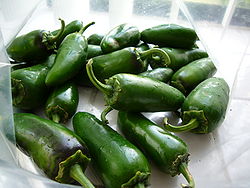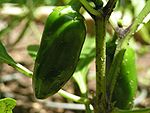Jalapeno
| Jalapeno |
|---|
| Scientific Classification |
|
| Cultivar |
|
Jalapeno |
The Jalapeno is a hot pepper that is very common for many people to eat. The Jalapeno pepper has a hotness to it that most people enjoy. For people who are not aware of the hotness of the pepper before eating it and they just can't stand the heat, they should consume dairy products such as milk, yogurt, or ice cream. The reason dairy products work is because the dairy contains a chemical called caisen, which fights against the hotness of the peppers capsicum by destroying it's receptor site. Jalapenos are named after the city of Xalapa, Veracruz.[1]
Anatomy
The anatomy of a Jalapeno pepper has a basic inside of a regular vegetable. At the base of the pepper is an apex. A little above the Apex on the inside is the Placenta (Capsaicin Glands). In the middle of the pepper are the seeds. Above the seeds is the Endocarp, then comes the Mesocarp above that, lastly is the Exocarp. These are the layers of the Jalapeno. At the very top of the Jalapeno is the Penducle(stem). The base of the stem is the Calyx. The surrounding layer of the pepper is called the Shoulder.
People love Jalapeno peppers, most of them love the peppers because of it's spicy and hot flavor. The flavor in the Jalapeno pepper comes from the Capsaicin. You can not find a Capsaicin in any other plant beside the chili pepper. Capsaicin is orderless and tasteless. The Placenta, is removed along with the seeds, usually are removed when preparing. This is because the Placenta is sixteen times hotter than the rest of the pepper.
When observing the Jalapeno, scientist have seen that small rodents do not particularly care for the Jalapeno. Birds are the opposite and are immune to the Jalapeno's hotness. This could be helpful to the farmer. This is because if birds eat the pepper and consume the seeds, the birds will poop out their droppings, which would have the seeds all over the field.[2]
Reproduction
When you are reproducing the Jalapeno pepper, there are specific steps you have to take to ensure a pepper with full taste. You should plant around two to three seeds in a seed tray. Give it water. Different seed types ask for different directions but these are the main idea. Keeping the soil wet is key when planting. When the sprouts start showing, it is good to keep the tray with the seeds in a dark environment. Once sprouted take the lids off and put them on a window sill to get sunlight. It is advised to turn the plant so that every part of it will see the sun so it will grow up right. Once around two to four leaves start showing, it is necessary to separate the plants into a bigger container[3].
Ecology
When planting the jalapeno seed there must be certain conditions of where the seed should be planted. First of all the weather has to be on the warmer, sunnier side. If the pepper is planted to early it could stunt its growth. If weather is not always acceptable for the requirements for the jalapeno, it is suggested to start your plant indoors and wait untill conditions are better. The jalapeno seeds usually grow slowly. The requirements for it to grow properly is that it must be at least 76 degrees Fahrenheit[[4]].
History
The Jalapeno is dated back a very long time ago. It was a popular plant that was used in many different ways. Thousand acres of the Jalapeno plant had been planted in Europe around the 1500's. The pepper seed had been with the European settlers when they went to North America, it evolved there and farmers crossed planted the seed to make different renditions of it. The crop became very important to American Indian tribes in 1696. A famine had gone through the live stalk during 1696, which wiped out almost all plants and food for the Indians, the pepper however survived and saved a lot of human lives.[5]
References
- Jalapeno Madness Michael Hultquist. Quist Interactive. 6/8/11
- When to plant Jalapeno seeds E. D. Palmer. eHow Contributor. March 18, 2011
- Chili Pepper Facts Gary L. Simmons. unknown. 4/16/2010


